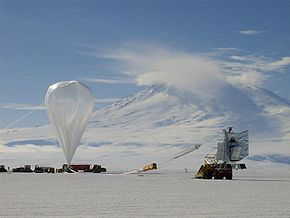
Back تجربة بوميرانج Arabic বুমেরাং পরীক্ষা Bengali/Bangla BOOMERanG Czech BOOMERanG German آزمایش بومرنگ Persian BOOMERanG-koe Finnish BOOMERanG French Experimento BOOMERanG Galician Esperimento BOOMERanG Italian BOOMERanG Japanese
 The telescope being readied for launch | |
| Alternative names | Balloon Observations Of Millimetric Extragalactic Radiation and Geophysics |
|---|---|
| Location(s) | Antarctica |
| Telescope style | balloon-borne telescope cosmic microwave background experiment radio telescope |
| Website | cmb |
| | |
| Part of a series on |
| Physical cosmology |
|---|
 |
BOOMERanG experiment (Balloon Observations Of Millimetric Extragalactic Radiation And Geophysics) was an experiment that flew a telescope on a (high-altitude) balloon and measured the cosmic microwave background radiation of a part of the sky during three sub-orbital flights. It was the first experiment to make large, high-fidelity images of the CMB temperature anisotropies, and is best known for the discovery in 2000 that the geometry of the universe is close to flat,[1] with similar results from the competing MAXIMA experiment.
By using a telescope which flew at over 42,000 meters high, it was possible to reduce the atmospheric absorption of microwaves to a minimum. This allowed massive cost reduction compared to a satellite probe, though only a tiny part of the sky could be scanned.
The first was a test flight over North America in 1997. In the two subsequent flights in 1998 and 2003 the balloon was launched from McMurdo Station in the Antarctic. It was carried by the Polar vortex winds in a circle around the South Pole, returning after two weeks. From this phenomenon the telescope took its name.
The BOOMERanG team was led by Andrew E. Lange of Caltech and Paolo de Bernardis of the University of Rome La Sapienza.[2]
- ^ de Bernardis, P.; et al. (27 April 2000). "A Flat Universe from High-Resolution Maps of the Cosmic Microwave Background Radiation". Nature. 404 (6781): 955–959. arXiv:astro-ph/0004404. Bibcode:2000Natur.404..955D. doi:10.1038/35010035. PMID 10801117. S2CID 4412370.
- ^ Glanz, James (27 April 2000). "Clearest Picture of Infant Universe Sees It All and Questions It, Too". The New York Times. Retrieved 2010-02-23.